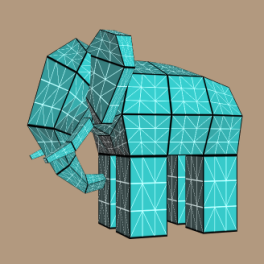
Screenspace adaptive with min edge length of 2.0 Screenspace adaptive with min edge length of 8.0 If you are adding displacement on simple angular meshes (such as walls or a box) and don't want them turned into smooth, curvy objects, disabling smooth subdivision might be the right option for you. This controls whether Redshift should subdivide quads and triangles using the Catmull-Clark and Loop algorithms respectively or whether it should do a simple linear subdivision instead. This option affects the unit used for the "minimum edge length" setting, as explained below. If this option is disabled, then subdivision becomes "world space adaptive".

Screen Space AdaptiveĮnabling screen-space adaptive tessellation means that objects that are further away from the camera will be subdivided less and will, therefore, use fewer polygons and less GPU memory.

#Tessellation shader software
The "CC Only" mode should be used when Redshift is combined with other software that doesn't support Loop subdivision. On the other hand, the "CC Only" option uses Catmull-Clark for triangles too, by first splitting each triangle into three quads. The "CC+Loop" subdivision rule uses Catmull-Clark for quads and Loop for triangles. These algorithms are also called "Subdivision Rules". Redshift supports two different algorithms for polygon subdivision: "Loop", which is used for triangles and "Catmull-Clark", which is used for quads. The object Tessellation and Displacement options are part of the RedshiftObjectSettings node. Importantly, any displacement detail that couldn't be represented given the existing tessellation settings is represented, instead, using bump mapping – therefore a good level of surface detail can be present even in fairly low-quality tessellation settings.
The vector displacement maps can be in object or tangent space. Redshift supports both heightfield (displacing along the vertex normal) and vector displacement maps. A displacement (or vector displacement) map allows this sculpted detail to be applied on a fairly low-resolution mesh.īecause displacement can happen on adaptively tessellated meshes, it can be more memory efficient than using a full-detail, full-tessellation mesh in memory at all times and irrespective of its size or viewpoint. Sculpting apps like ZBrush and Mudbox are easier to use compared to polygon modeling when creating organic geometry.Manipulating textures and shader networks for certain displacement effects (such as a brick wall) is much easier than manipulating lots of vertices in a 3D program.It allows the user to add extra detail on their meshes through shader networks, i.e. Displacement is a technique typically combined with tessellation. Redshift supports both screen-space and world-space adaptive tessellation for improved memory usage. For triangles, it uses the Loop algorithm. Redshift subdivides quad polygons using the Catmull-Clark algorithm. Small or distant objects, for example, can render smooth with fewer subdivisions. It can be more memory-efficient (which is important for GPUs) when combined with view-dependent and/or adaptive subdivision.



 0 kommentar(er)
0 kommentar(er)
